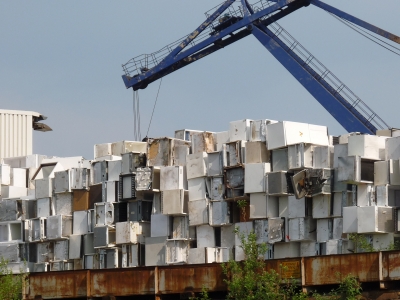These are the conclusions drawn from a comparative life cycle assessment study of four different treatment options that was conducted by Oeko-Institut on behalf of the RAL Quality Assurance Association for the Demanufacture of Refrigeration Equipment.
Although about half of the appliances now arriving for treatment no longer contain the climatically harmful CFCs (containing instead hydrocarbons as the refrigerant and pentane as the blowing agent for the insulation foam), the joint processing of these appliances is still necessary in order to ensure high-quality, environmentally sound recycling of waste refrigeration equipment. Failure to carry out joint processing results in 4800 kilograms of CFCs being released in to the atmosphere each year and creates an additional global warning potential of up to 54,000 metric tons of CO2 equivalents annually.
Today, EU member states must ensure that waste refrigeration appliances are treated in dedicated fridge recycling plants. No matter whether the foam blowing agents and refrigerants in these appliances are CFCs or not, the most environmentally compatible treatment involves the simultaneous processing of appliances containing CFCs and those containing hydrocarbons in a single plant – an approach known as joint processing. This requirement of the EU Directive on Waste Electrical and Electronic Equipment (WEEE) was also adopted in European Standard EN 50574, which contains comprehensive rules governing the recycling of waste refrigeration equipment. The incoming appliances are not sorted prior to treatment as the sorting process is prone to error. The CFCs and the hydrocarbons (HCs) are safely recovered in the recycling plant and do not escape in an uncontrolled manner into the environment – as is the case with other treatment methods. The metals, plastics and glass fractions recovered undergo downstream mechanical recycling.
Compared to other treatment options, the joint processing of waste refrigeration appliances currently saves up to 54,000 metric tons of greenhouse gases a year. This corresponds to the annual carbon emissions from up to 19,000 cars in Germany, based on average car emissions of 205 grams CO2 equivalents per kilometre and assuming that on average a car drives 14,000 kilometres each year. Even in 2020, when 90 percent of the appliances sent for end-of-life treatment will contain HCs, the study shows that joint processing still yields important environmental outcomes, with savings of around 37,000 metric tons of CO2equivalents annually.
‘Joint processing meets the EU requirement that CFCs and hydrocarbons must be removed from waste refrigeration appliances and then safely destroyed,’ explains Dr. Doris Schüler, who led the study at Oeko-Institut. ‘This means, however, that end-of-life processing must be carried out by professional fridge recycling companies where waste appliances are treated together so that the problems associated with sorting errors do not occur.’








